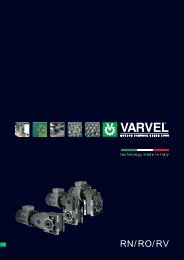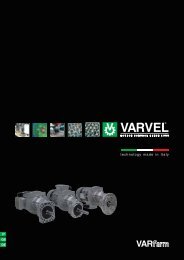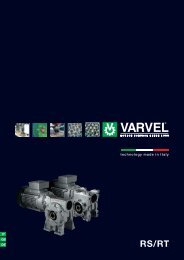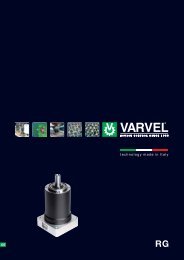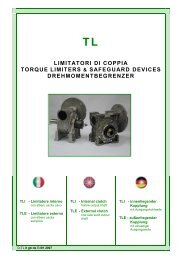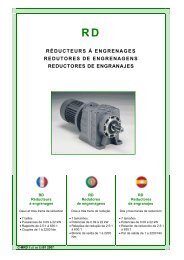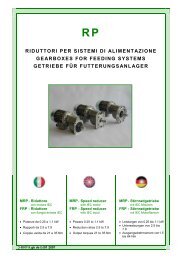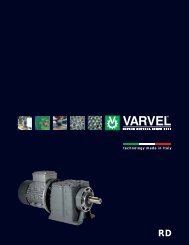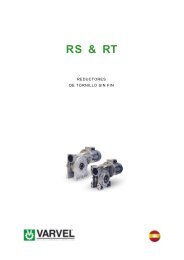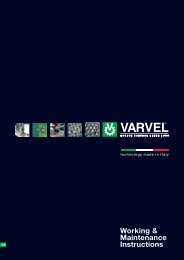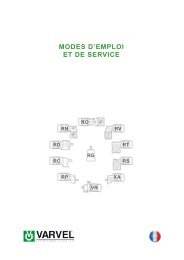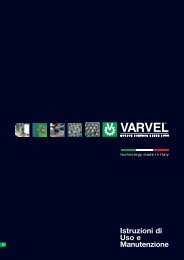Instrucciones de Utilización y Mantenimiento - Varvel SpA
Instrucciones de Utilización y Mantenimiento - Varvel SpA
Instrucciones de Utilización y Mantenimiento - Varvel SpA
Create successful ePaper yourself
Turn your PDF publications into a flip-book with our unique Google optimized e-Paper software.
ES<br />
technology ma<strong>de</strong> in Italy<br />
<strong>Instrucciones</strong><br />
<strong>de</strong> <strong>Utilización</strong> y<br />
<strong>Mantenimiento</strong>
Tecnología Ma<strong>de</strong> in Italy<br />
Des<strong>de</strong> 1955 <strong>Varvel</strong> proyecta y fabrica reductores y variadores<br />
<strong>de</strong> velocidad para aplicaciones <strong>de</strong> pequeña y mediana potencia.<br />
Socio fiable para la producción y venta <strong>de</strong> órganos <strong>de</strong> transmisión<br />
gracias a un elevado nivel <strong>de</strong> servicio, ofrece también soluciones<br />
personalizadas actuando con el respeto a los valores <strong>de</strong> la<br />
empresa socialmente responsable. Modularidad y flexibilidad<br />
guían el diseño <strong>de</strong> los productos <strong>Varvel</strong> mediante la realización<br />
<strong>de</strong> kits comunes a toda la familia <strong>de</strong> reductores, facilitando así la<br />
gestión <strong>de</strong> los distribuidores y reven<strong>de</strong>dores que pue<strong>de</strong>n configurar<br />
en pocos minutos el producto solicitado por cada cliente.
INSTRUCCIONES DE UTILIZACIÓN<br />
Y MANTENIMIENTO<br />
RO<br />
RN RV<br />
RD RT<br />
RG<br />
RC RS<br />
RP XA<br />
VR
<strong>Instrucciones</strong> <strong>de</strong> <strong>Utilización</strong> y <strong>Mantenimiento</strong><br />
Índice<br />
1 INFORMACIONES GENERALES .............................................................................................................................................. 3<br />
2 INSTRUCCIONES DE SEGURIDAD<br />
2.1 Funcionamiento Productos ......................................................................................................................................... 3<br />
2.2 <strong>Utilización</strong> predominante ............................................................................................................................................ 3<br />
2.3 Transporte ................................................................................................................................................................. 3<br />
2.4 Conservación prolongada ........................................................................................................................................... 3<br />
2.5 Gestión Ambiental ...................................................................................................................................................... 3<br />
3 COMPOSICIÓN DE LOS PRODUCTOS .................................................................................................................................. 3<br />
Acoplamiento Elástico G ................................................................................................................................................... 4<br />
Reductores Serie RC ........................................................................................................................................................ 5<br />
Reductores Serie RD ........................................................................................................................................................ 6<br />
Reductores Serie RG ....................................................................................................................................................... 8<br />
Reductores Serie RN ...................................................................................................................................................... 10<br />
Reductores Serie RO ..................................................................................................................................................... 12<br />
Reductores Serie RV ...................................................................................................................................................... 13<br />
Reductores Serie RP/XA ................................................................................................................................................ 14<br />
Reductores Serie RS ...................................................................................................................................................... 15<br />
Reductores Serie RT ...................................................................................................................................................... 16<br />
Opción Limitadores <strong>de</strong> par TLE ....................................................................................................................................... 17<br />
Opción Limitadores <strong>de</strong> par TLI ....................................................................................................................................... 18<br />
Variadores Serie VR ....................................................................................................................................................... 19<br />
Variadores Serie VS ....................................................................................................................................................... 20<br />
4 INSTALACIÓN ................................................................................................................................................................................. 21<br />
4.1 Tolerancias ............................................................................................................................................................... 21<br />
4.2 Precauciones ........................................................................................................................................................... 21<br />
4.3 Preparación ............................................................................................................................................................. 21<br />
4.4 Instalación ................................................................................................................................................................ 21<br />
4.5 Poleas, Piñones, Acoplamientos ............................................................................................................................. 21<br />
4.6 Brazo <strong>de</strong> reacción ..................................................................................................................................................... 21<br />
4.7 Pintura ..................................................................................................................................................................... 21<br />
5 ARRANQUE ................................................................................................................................................. 22<br />
5.1 Series RS, RT ........................................................................................................................................................... 22<br />
5.2 Series RC, RD, RP, XA, VR ..................................................................................................................................... 22<br />
6 INSPECCIÓNES Y MANTENIMIENTO ................................................................................................................................... 22<br />
6.1 Intervalos ................................................................................................................................................................. 22<br />
6.2 Servicio mantenimiento ............................................................................................................................................ 22<br />
7 DEFECTOS DE FUNCIONAMIENTO ...................................................................................................................................... 24<br />
7.1 Casos mas frecuentes .............................................................................................................................................. 24<br />
7.2 Servicio al cliente ...................................................................................................................................................... 24<br />
8 LUBRIFICANTES ............................................................................................................................................................................ 25<br />
8.1 Tipos recomendados ................................................................................................................................................ 25<br />
8.2 Cantidad .................................................................................................................................................................. 25<br />
9 DIRECTIVA 94/9/CE - (ATEX) ................................................................................................................................................. 28<br />
10 DECLARACIÓN DE CONFORMIDAD ................................................................................................................................. 32<br />
.<br />
- 2 -
<strong>Instrucciones</strong> <strong>de</strong> <strong>Utilización</strong> y <strong>Mantenimiento</strong><br />
Informaciones Generales - <strong>Instrucciones</strong> <strong>de</strong> Seguridad - Composición <strong>de</strong> los Productos<br />
1 INFORMACIONES GENERALES<br />
Los reductores y variadores <strong>de</strong> velocidad no recaen en el campo <strong>de</strong> aplicación <strong>de</strong> la Directiva Máquinas 2006/42/CE, en<br />
cuanto son consi<strong>de</strong>rados "componentes <strong>de</strong> máquina.".<br />
El art. 35 <strong>de</strong> la guía a la Directiva Máquinas establece:<br />
"La Directiva Máquinas no se aplica directamente a los componentes <strong>de</strong> las máquinas, cuales, por ejemplo, las válvulas,<br />
los cilindros oleoidraulicos o los reductores <strong>de</strong> velocidad, que no tienen una aplicación específica en cuánto tales, pero<br />
son <strong>de</strong>stinados a ser incorporados en las máquinas, aunque el planeamiento y la construcción <strong>de</strong> dichos componentes<br />
<strong>de</strong>ban ser tales que vuelvan la máquina completada conforme a los requisitos pertinentes y fundamentales en materia <strong>de</strong><br />
seguridad y <strong>de</strong> tutela <strong>de</strong> la salud.".<br />
Un funcionamiento correcto y el <strong>de</strong>recho a la asistencia en garantía, requieren la observancia <strong>de</strong> la información contenida<br />
en este manual que <strong>de</strong>be ser leído antes <strong>de</strong> la puesta en marcha <strong>de</strong>l reductor.<br />
2 INSTRUCCIÓNES DE SEGURIDAD<br />
2.1 Funcionamiento <strong>de</strong> los Productos<br />
Durante el funcionamiento, las superficies externas <strong>de</strong> los reductores y variadores pue<strong>de</strong>n calentarse a causa <strong>de</strong> los elementos<br />
en movimiento y <strong>de</strong> las condiciones ambientales externas.<br />
Todo lo referente al transporte, almacenaje, montaje, conexionado, arranque y mantenimiento <strong>de</strong>be ser efectuado por<br />
personal formado siguiendo este manual, y <strong>de</strong>ntro <strong>de</strong> las regulaciones específicas nacionales/ regionales sobre seguridad<br />
y prevención <strong>de</strong> acci<strong>de</strong>ntes.<br />
2.2 <strong>Utilización</strong> predominante<br />
Los reductores y variadores <strong>de</strong>l presente manual están <strong>de</strong>stinados al uso en aplicaciones industriales y correspon<strong>de</strong>n a<br />
los estándares y regulaciones don<strong>de</strong> y cuando fuesen aplicables.<br />
Prestaciones y datos técnicos figuran en la placa <strong>de</strong> características y la correspondiente documentación.<br />
2.3 Transporte<br />
Verificar con atención el estado <strong>de</strong> la mercancía en la recepción y notificar eventualmente los daños al transportista.<br />
2.4 Conservación prolongada en almacén<br />
Los grupos almacenados, <strong>de</strong>ben ser mantenidos en ambiente seco y protegido <strong>de</strong>l polvo.<br />
Para permanencias superiores a los tres meses, es una buena norma aplicar antioxidante sobre los ejes y planos mecanizados,<br />
prestando especial atención a las zonas <strong>de</strong> trabajo <strong>de</strong>l labio <strong>de</strong> los retenes.<br />
Las permanencias superiores a un año reducen la duración <strong>de</strong> la grasa <strong>de</strong> los rodamientos.<br />
2.5 Gestión Ambiental <strong>de</strong>l producto<br />
En conformidad a la Certificación Ambiental ISO 14001, recomendamos seguir las siguientes indicaciones para el <strong>de</strong>sguace<br />
<strong>de</strong> nuestros productos:<br />
los componentes <strong>de</strong>l grupo que sean para chatarra, <strong>de</strong>berán ser entregados a centros <strong>de</strong> recogida autorizados para<br />
materiales metálicos;<br />
aceites y lubrificantes recogidos <strong>de</strong>l grupo <strong>de</strong>berán ser entregados a centros <strong>de</strong> tratamiento <strong>de</strong> aceites usados;<br />
embalajes (paletas, cartón, papel, plástico, etc.) <strong>de</strong>ben ser orientados en lo posible hacia su recuperación/reciclaje,<br />
entregándolos a empresas autorizadas para cada tipo <strong>de</strong> residuo.<br />
3 COMPOSICIÓN DE LOS PRODUCTOS<br />
La finalidad <strong>de</strong> los siguientes <strong>de</strong>spieces, es la i<strong>de</strong>ntificación genérica <strong>de</strong> los componentes <strong>de</strong> los distintos tipos <strong>de</strong> productos.<br />
Las diversas ejecuciones <strong>de</strong>l producto, tamaño, forma <strong>de</strong> montaje. número <strong>de</strong> trenes, originan en realidad soluciones<br />
diferentes y por lo tanto se recomienda solicitar la documentación específica y/o contactar nuestra Oficina Técnica.<br />
- 3 -
<strong>Instrucciones</strong> <strong>de</strong> <strong>Utilización</strong> y <strong>Mantenimiento</strong><br />
Composición <strong>de</strong> los Productos<br />
Acoplamiento Elástico “G”<br />
El acoplamiento elástico "G" es provisto como instalación estándar sobre los productos <strong>de</strong> las Series RD, RN, RO, RV,<br />
RP, RS, RT.<br />
Semiacoplamiento reductor<br />
Material: Aleación <strong>de</strong> acero<br />
Integral con el eje <strong>de</strong> entrada<br />
Soportado por dos rodamientos<br />
Dimensiones entrada sin cambio<br />
Elemento elástico<br />
Dientes estrella: unidos externamente<br />
Material: Elastómero termoplástico<br />
- Elastollan ® TPU - Termoplástico Poliuretanico<br />
- Hytrel ® TPE - Termoplástico Poliéster<br />
Dureza<br />
- TPU 98 Shore A<br />
- TPE 72 Shore D<br />
Temperatura<br />
- TPU -20/+75°C (-4 / +167°F)<br />
- TPE -30/+100°C (-22 / +212°F)<br />
Semiacoplamiento motor<br />
Material:<br />
- Aluminio inyectado (G3, G5, G6)<br />
- Aleación <strong>de</strong> acero (GS8)<br />
Equilibrado dinámicamente<br />
Fijación:<br />
- Apriete (G3, G5, G6)<br />
- Chaveta (GS8)<br />
Agujeros:<br />
- IEC 72 / N42948<br />
- NEMA C y TC<br />
Ventajas:<br />
Un solo reductor por reducción<br />
Mayor flexibilidad<br />
Rotación aumentada <strong>de</strong>l stock<br />
Eliminación óxido por rozamiento entre chaveta y chavetero (tribocorrosión)<br />
Juego cero en la conexión<br />
Desalineamiento angular admitido 1° máx.<br />
Rigi<strong>de</strong>z torsional<br />
Amortiguación <strong>de</strong> las vibraciones<br />
Bridas <strong>de</strong> entrada:<br />
Material:<br />
- Aluminio hasta IEC112 y NEMA TC180<br />
- Hierro fundido <strong>de</strong>s<strong>de</strong> IEC 132 y NEMA TC200<br />
- 4 -
RC<br />
<strong>Instrucciones</strong> <strong>de</strong> <strong>Utilización</strong> y <strong>Mantenimiento</strong><br />
- 5 -<br />
Composición <strong>de</strong> los Productos<br />
Serie RC - 2 trenes<br />
El siguiente <strong>de</strong>spiece muestra a título indicativo, la estructura general <strong>de</strong> un reductor <strong>de</strong> engranajes <strong>de</strong> dos trenes <strong>de</strong><br />
reducción con patas tipo FRC (tamaños 05 hasta 30).<br />
01 Retén 19 Rodamiento<br />
02 Carcasa 20 Rodamiento<br />
03 Chaveta 21 Piñón<br />
04 Eje salida 22 Chaveta<br />
05 Chaveta 23 Corona<br />
06 Rodamiento 24 Rodamiento<br />
07 Distanciador 26 Rodamiento<br />
11 Junta 27 Corona<br />
13 Rodamiento 29 Tapa-brida IEC<br />
15 Piñón 33 Eje entrada hueco con 1° piñón<br />
16 Chaveta 35 Retén<br />
17 Eje <strong>de</strong> entrada hueco
<strong>Instrucciones</strong> <strong>de</strong> <strong>Utilización</strong> y <strong>Mantenimiento</strong><br />
Composición <strong>de</strong> los Productos<br />
Serie RD - 2 trenes<br />
El siguiente <strong>de</strong>spiece muestra a título indicativo, la estructura general <strong>de</strong> un reductor <strong>de</strong> engranajes tipo FRD <strong>de</strong> dos trenes<br />
<strong>de</strong> reducción con patas.<br />
01 Tapa <strong>de</strong> entrada 54 Corona<br />
02A Eje <strong>de</strong> entrada hueco IEC 55 Distanciador<br />
02B Eje <strong>de</strong> entrada hueco “G” 56 Seeger<br />
04 Piñón 65 Rodamiento<br />
15 Rodamiento 66 Rodamiento<br />
16 Rodamiento 67 Rodamiento<br />
20 Retén 68 Rodamiento<br />
41 Corona 69 Retén<br />
50 Carcasa 82 Junta<br />
51 Tapa 85 Brida motor<br />
52 Eje <strong>de</strong> salida<br />
53 Piñón<br />
- 6 -<br />
RD
RD<br />
<strong>Instrucciones</strong> <strong>de</strong> <strong>Utilización</strong> y <strong>Mantenimiento</strong><br />
- 7 -<br />
Composición <strong>de</strong> los Productos<br />
Series RD - 3 trenes<br />
El siguiente <strong>de</strong>spiece muestra a título indicativo, la estructura general <strong>de</strong> un reductor <strong>de</strong> engranajes tipo FRD <strong>de</strong> tres trenes<br />
<strong>de</strong> reducción con patas.<br />
01 Tapa <strong>de</strong> entrada 40 Piñón 68 Rodamiento<br />
02A Eje <strong>de</strong> entrada hueco IEC 41 Corona 69 Retén<br />
02B Eje <strong>de</strong> entrada hueco “G” 50 Carcasa 82 Junta<br />
03 Eje 3° tren 51 Tapa 85 Brida motor<br />
04 Piñón 52 Eje <strong>de</strong> salida<br />
05 Corona 53 Piñón<br />
15 Rodamiento 54 Corona<br />
16 Rodamiento 55 Distanciador<br />
17 Rodamiento 56 Distanciador<br />
18 Rodamiento 65 Rodamiento<br />
19 Distanciador 66 Rodamiento<br />
20 Retén 67 Rodamiento
<strong>Instrucciones</strong> <strong>de</strong> <strong>Utilización</strong> y <strong>Mantenimiento</strong><br />
Composición <strong>de</strong> los Productos<br />
Serie RG - 1 tren<br />
El siguiente <strong>de</strong>spiece muestra a título indicativo, la estructura general <strong>de</strong> un reductor planetario tipo FRG <strong>de</strong> un tren <strong>de</strong><br />
reducción con brida.<br />
01 Tornillo 13 Piñón central<br />
02 Tapón 14 Cuerpo corona<br />
03 Brida motor 15 Satélite<br />
04 Tornillo 16 Rodamiento rodillos<br />
05 Brida entrada 17 Perno satélite<br />
06 Tapón 18 Eje porta satélite<br />
07 Casquillo elástico 19 Chaveta<br />
08 Anillo <strong>de</strong> apriete 20 Rodamiento<br />
09 Rodamiento 21 Seeger<br />
10 Eje <strong>de</strong> entrada 22 Espesor<br />
11 Espesor 23 Rodamiento<br />
12 Distanciador 24 Seeger<br />
- 8 -<br />
RG
RG<br />
<strong>Instrucciones</strong> <strong>de</strong> <strong>Utilización</strong> y <strong>Mantenimiento</strong><br />
- 9 -<br />
Composición <strong>de</strong> los Productos<br />
Series RG - 2 trenes<br />
El siguiente <strong>de</strong>spiece muestra a título indicativo, la estructura general <strong>de</strong> un reductor planetario tipo FRG <strong>de</strong> dos trenes<br />
<strong>de</strong> reducción con brida.<br />
01 Tornillo 13 Piñón central 25 Rodamiento<br />
02 Tapón 14 Cuerpo corona 26 Seeger<br />
03 Brida motor 15 Satélite 27 Espesor<br />
04 Tornillo 16 Rodamiento rodillos 28 Rodamiento<br />
05 Brida entrada 17 Perno satélite 29 Seeger<br />
06 Tapón 18 Eje porta satélites<br />
07 Casquillo elástico 19 Satélite<br />
08 Anillo <strong>de</strong> apriete 20 Rodamiento rodillos<br />
09 Rodamiento 21 Perno satélite<br />
10 Eje <strong>de</strong> entrada 22 Distanciador<br />
11 Espesor 23 Eje porta satélite<br />
12 Distanciador 24 Chaveta
<strong>Instrucciones</strong> <strong>de</strong> <strong>Utilización</strong> y <strong>Mantenimiento</strong><br />
Composición <strong>de</strong> los Productos<br />
Series RN - 2 trenes<br />
El siguiente <strong>de</strong>spiece muestra a título indicativo, la estructura general <strong>de</strong> un reductor <strong>de</strong> ejes paralelos tipo FRN <strong>de</strong> dos<br />
trenes <strong>de</strong> reducción con eje <strong>de</strong> salida hueco.<br />
01 Brida <strong>de</strong> entrada 13 Rodamiento 25 Distanciador<br />
02 Retén 14 Chaveta 26 Rodamiento<br />
03 Seeger 15 Piñón 27 Seeger<br />
04 Rodamiento 16 Rodamiento 28 Retén<br />
05 Eje <strong>de</strong> entrada 17 Seeger<br />
06 Rodamiento 18 Retén<br />
07 Tapa 2 trenes 19 Seeger<br />
08 Piñón 20 Rodamiento<br />
09 Retén RCA 21 Carcasa<br />
10 Seeger 22 Chaveta<br />
11 Corona 23 Eje hueco <strong>de</strong> salida<br />
12 Distanciador 24 Corona<br />
- 10 -<br />
RN
RN<br />
<strong>Instrucciones</strong> <strong>de</strong> <strong>Utilización</strong> y <strong>Mantenimiento</strong><br />
- 11 -<br />
Composición <strong>de</strong> los Productos<br />
Series RN - 3 trenes<br />
El siguiente <strong>de</strong>spiece muestra a título indicativo, la estructura general <strong>de</strong> un reductor <strong>de</strong> ejes paralelos tipo FRN <strong>de</strong> tres<br />
trenes <strong>de</strong> reducción con eje <strong>de</strong> salida hueco.<br />
01 Brida motor 13 Eje intermedio 25 Seeger<br />
02 Retén 14 Rodamiento 26 Retén<br />
03 Seeger 15 Seeger 27 Seeger<br />
04 Rodamiento 16 Piñón 28 Rodamiento<br />
05 Eje entrada 17 Retén RCA 29 Distanciador<br />
06 Rodamiento 18 Seeger 30 Corona<br />
07 Piñón 19 Rodamiento 31 Eje hueco <strong>de</strong> salida<br />
08 Pata 3 trenes 20 Piñón 32 Chaveta<br />
09 Rodamiento 21 Chaveta 33 Carcasa<br />
10 Corona 22 Rodamiento 34 Rodamiento<br />
11 Distanciador 23 Distanciador 35 Seeger<br />
12 Chaveta 24 Corona 36 Retén
<strong>Instrucciones</strong> <strong>de</strong> <strong>Utilización</strong> y <strong>Mantenimiento</strong><br />
Composición <strong>de</strong> los Productos<br />
Serie RO<br />
El siguiente <strong>de</strong>spiece muestra a título indicativo, la estructura general <strong>de</strong> un reductor <strong>de</strong> ejes ortogonales tipo FRO <strong>de</strong><br />
tres trenes <strong>de</strong> reducción con eje <strong>de</strong> salida hueco.<br />
01 Brida motor 13 Corona Gleason 25 Eje hueco <strong>de</strong> salida<br />
02 Retén 14 Espesor 26 Carcasa<br />
03 Seeger 15 Rodamiento 27 Seeger<br />
04 Eje entrada 16 Tapa 28 Rodamiento<br />
05 Rodamiento 17 Piñón 29 Piñón<br />
06 Piñón Gleason 18 Retén RCA 31 Rodamiento<br />
07 Retén RCA 19 Retén 32 Espesor<br />
08 Seeger 20 Seeger 33 Corona<br />
09 Rodamiento 21 Rodamiento 34 Seeger<br />
10 Chaveta 22 Espesor 35 Rodamiento<br />
11 Eje 23 Corona 36 Seeger<br />
12 Espesor 24 Chaveta 37 Retén<br />
- 12 -<br />
RO
RV<br />
<strong>Instrucciones</strong> <strong>de</strong> <strong>Utilización</strong> y <strong>Mantenimiento</strong><br />
- 13 -<br />
Composición <strong>de</strong> los Productos<br />
Serie RV<br />
El siguiente <strong>de</strong>spiece muestra a título indicativo, la estructura general <strong>de</strong> un reductor <strong>de</strong> ejes ortogonales tipo FRV <strong>de</strong><br />
tres trenes <strong>de</strong> reducción con eje <strong>de</strong> salida hueco.<br />
01 Brida motor 13 Rodamiento 25 Rodamiento<br />
02 Retén 14 Eje 26 Seeger<br />
03 Seeger 15 Chaveta 27 Retén<br />
04 Eje entrada 16 Rodamiento 28 Seeger<br />
05 Rodamiento 17 Seeger 29 Rodamiento<br />
06 Piñón Gleason 18 Retén RCA 30 Carcasa<br />
07 Retén RCA 19 Seeger 31 Eje hueco <strong>de</strong> salida<br />
08 Piñón 20 Corona 33 Corona<br />
09 Tapa 21 Espesor 34 Espesor<br />
10 Rodamiento 22 Rodamiento 35 Rodamiento<br />
11 Espesor 23 Chaveta 36 Seeger<br />
12 Corona Gleason 24 Piñón 37 Retén
<strong>Instrucciones</strong> <strong>de</strong> <strong>Utilización</strong> y <strong>Mantenimiento</strong><br />
Composición <strong>de</strong> los Productos<br />
Series RP y XA<br />
FXA<br />
- 14 -<br />
FRP90<br />
RP & XA<br />
El siguiente <strong>de</strong>spiece muestra a título indicativo, la estructura general <strong>de</strong> un reductor <strong>de</strong> engranajes tipo FRP y FXA <strong>de</strong><br />
un tren <strong>de</strong> reducción con brida.<br />
01 Carcasa 15 Rodamiento<br />
02 Seeger 16 Rodamiento<br />
03 Retén 18 Seeger<br />
04 Eje <strong>de</strong> salida 19 Rodamiento<br />
05 Chaveta 20 Chaveta<br />
060 Tornillo 21 Casquillo<br />
70 Rodamiento 24 Seeger<br />
08 Corona 25 Distanciador<br />
10 Brida motor 26 Tapón<br />
11 Seeger 27 Acoplamiento<br />
12 Retén<br />
13 Piñón
RS<br />
<strong>Instrucciones</strong> <strong>de</strong> <strong>Utilización</strong> y <strong>Mantenimiento</strong><br />
- 15 -<br />
Composición <strong>de</strong> los Productos<br />
El siguiente <strong>de</strong>spiece muestra a título indicativo, la estructura general <strong>de</strong> un reductor <strong>de</strong> vis-sin-fin FRS con patas.<br />
Serie RS<br />
Las ejecuciones Serie RA (tren cilíndrico / tornillo sin fin) son efectuados con el montaje <strong>de</strong>l reductor con un tren <strong>de</strong> engranajes<br />
Serie XA sobre el reductor estándar vis-sin-fin <strong>de</strong> la Serie RS y las ejecuciones a doble tornillo sin fin con el<br />
montaje <strong>de</strong> dos reductores <strong>de</strong> la Serie RS y oportuno kit <strong>de</strong> combinación.<br />
01 Carcasa 82 Retén<br />
04 Tapa 84 Retén RCA<br />
07 Brida motor 125 Seeger<br />
31 Corona 126 Seeger<br />
50A Vis-sin-fin IEC<br />
50B Vis-sin-fin “G”<br />
60 Rodamiento<br />
61 Rodamiento<br />
62 Rodamiento<br />
63 Rodamiento<br />
80 Retén<br />
81 Retén
<strong>Instrucciones</strong> <strong>de</strong> <strong>Utilización</strong> y <strong>Mantenimiento</strong><br />
Composición <strong>de</strong> los Productos<br />
Serie RT<br />
El siguiente <strong>de</strong>spiece muestra a título indicativo, la estructura general <strong>de</strong> un reductor <strong>de</strong> vis-sin-fin FRT con patas.<br />
Las ejecuciones Serie TA (tren cilíndrico / tornillo sin fin) son efectuados con el montaje <strong>de</strong>l reductor con un tren <strong>de</strong> engranajes<br />
Serie XA sobre el reductor estándar vis-sin-fin <strong>de</strong> la Serie RT y las ejecuciones a doble tornillo sin fin con el<br />
montaje <strong>de</strong> dos reductores <strong>de</strong> la Serie RS y oportuno kit <strong>de</strong> combinación.<br />
01 Carcasa 84 Retén RCA<br />
04 Tapa 125 Seeger<br />
07 Brida motor 126 Seeger<br />
31 Corona<br />
50 Vis-sin-fin<br />
60 Rodamiento<br />
61 Rodamiento<br />
62 Rodamiento<br />
63 Rodamiento<br />
80 Retén<br />
81 Retén<br />
82 Retén<br />
- 16 -<br />
RT
TLE<br />
<strong>Instrucciones</strong> <strong>de</strong> <strong>Utilización</strong> y <strong>Mantenimiento</strong><br />
- 17 -<br />
Composición <strong>de</strong> los Productos<br />
TLE - Opción Limitadores <strong>de</strong> par<br />
El siguiente <strong>de</strong>spiece muestra a título indicativo, la estructura general <strong>de</strong> un limitador <strong>de</strong> par TLE montado en un reductor<br />
<strong>de</strong> vis-sin-fin Serie RS o RT.<br />
El limitador <strong>de</strong> par TLE es montado directamente en el eje hueco <strong>de</strong> los ya montados reductores sin ningún equipamiento<br />
particular.<br />
01 Volante 13 Anillo anterior<br />
02 Aran<strong>de</strong>la Belville 14 Fricción anterior<br />
03 Anillo espesor 15 Protección anterior<br />
04 Espesor 16 Casquillo anterior<br />
05 Protección posterior 17 Chaveta<br />
06 Aran<strong>de</strong>la Belville 18 Eje lento<br />
07 Chaveta<br />
08 Anillo <strong>de</strong> empuje<br />
09 Fricción posterior<br />
10 Anillo posterior<br />
11 Chaveta<br />
RS<br />
12 Casquillo posterior<br />
RT
<strong>Instrucciones</strong> <strong>de</strong> <strong>Utilización</strong> y <strong>Mantenimiento</strong><br />
Composición <strong>de</strong> los Productos<br />
- 18 -<br />
TLI<br />
TLI - Opción Limitadores <strong>de</strong> par<br />
El siguiente <strong>de</strong>spiece muestra a título indicativo, la estructura general <strong>de</strong> un limitador <strong>de</strong> par TLI montado en un reductor<br />
<strong>de</strong> vis-sin-fin MRS o MRT.<br />
RS<br />
01 Tuerca cilíndrica 81 Retén<br />
02 Aran<strong>de</strong>la Belville<br />
03 Casquillo<br />
04 Junta<br />
05 Chaveta<br />
06 Anillo<br />
07 Corona <strong>de</strong>ntada<br />
08 Eje <strong>de</strong> salida hueco<br />
10 Tapa<br />
60 Rodamiento<br />
61 Rodamiento<br />
80 Retén<br />
RT
VR<br />
Serie VR<br />
<strong>Instrucciones</strong> <strong>de</strong> <strong>Utilización</strong> y <strong>Mantenimiento</strong><br />
- 19 -<br />
Composición <strong>de</strong> los Productos<br />
El siguiente <strong>de</strong>spiece muestra a título indicativo, la estructura general <strong>de</strong> un variador tipo FVR sin trenes <strong>de</strong> engranajes<br />
con brida.<br />
01 Tornillo 14 Volante regulación 27 Distanciador<br />
02 Brida motor IEC 15 Bloqueo eje regulación 28 Rodamiento<br />
03 Tornillo 16 Eje regulación 29 Seeger<br />
04 Soporte junta 17 Retén OR 30 Retén<br />
05 Rodamiento 18 Tornillo 31 Escala índice<br />
06 Distanciador 19 Eje <strong>de</strong> salida 32 Seeger<br />
07 Cono 20 Chaveta 33 Muelle<br />
09 Carcasa 21 Rodamiento 34 Soporte anillo fricción<br />
10 Guía cilíndrica 22 Seeger 35 Anillo fricción<br />
11 Retén OR 23 Seeger 39 Soporte cono<br />
12 Retén OR 24 Retén 40 Junta fuelle<br />
13 Tornillo 26 Brida salida 41 Índice
<strong>Instrucciones</strong> <strong>de</strong> <strong>Utilización</strong> y <strong>Mantenimiento</strong><br />
Composición <strong>de</strong> los Productos<br />
Serie VS<br />
El siguiente <strong>de</strong>spiece muestra a título indicativo, la estructura general <strong>de</strong> un variador tipo FVS sin trenes <strong>de</strong> engranajes<br />
con brida.<br />
01 Eje <strong>de</strong> salida<br />
02 Porta satélite<br />
03 Casquillo <strong>de</strong>slizante<br />
04 Pista regulación<br />
05 Anillo porta bolas<br />
06 Pista móvil externa<br />
07 Satélite<br />
08 Caja <strong>de</strong> regulación<br />
09 Pista fija externa<br />
10 Pista fija interna<br />
11 Pista móvil interna<br />
12 Aran<strong>de</strong>las Belville<br />
- 20 -<br />
VS
4 INSTALACIÓN<br />
4.1 Tolerancias<br />
Tolerancias recomendadas según DIN 748:<br />
Ejes: sólido entrada o salida ISO h6<br />
hueco entrada ISO E8<br />
hueco salida ISO H7<br />
agujero central DIN 332,DR<br />
Bridas: centraje ISO h7<br />
4.2 Precauciones<br />
<strong>Instrucciones</strong> <strong>de</strong> <strong>Utilización</strong> y <strong>Mantenimiento</strong><br />
- 21 -<br />
Instalación<br />
Verificar que el grupo a instalar tenga las características aptas para realizar la función requerida y que la posición <strong>de</strong><br />
montaje sea acor<strong>de</strong> con el pedido. Tales características figuran en la placa <strong>de</strong> características.<br />
Verificar la estabilidad <strong>de</strong>l montaje para evitar vibraciones o sobrecargas durante el funcionamiento.<br />
Vigilar que el posicionamiento sea correcto y estable para evitar perjudicar el funcionamiento <strong>de</strong>l reductor.<br />
Para el levantamiento por grúa, utilizar el gancho provisto en la carcasa o en <strong>de</strong>fecto los agujeros <strong>de</strong> las patas o <strong>de</strong> las<br />
bridas, evitando utilizar las partes móviles.<br />
4.3 Preparación<br />
Limpiar cuidadosamente las superficies <strong>de</strong> los ejes y bridas prestando atención a que el producto utilizado no entre en<br />
contacto con el labio <strong>de</strong> los retenes para evitar todo perjuicio y pérdida <strong>de</strong> aceite.<br />
4.4 Instalación<br />
Los grupos pue<strong>de</strong>n girar en sentido horario o anti-horario.<br />
Parar inmediatamente el grupo en caso <strong>de</strong> funcionamiento <strong>de</strong>fectuoso o ruido anormal: si la parte <strong>de</strong>fectuosa no es sustituida,<br />
otras partes pue<strong>de</strong>n resultar dañadas y se hace difícil i<strong>de</strong>ntificar la causa.<br />
4.5 Poleas, Piñones, Acoplamiento<br />
Sobre el eje <strong>de</strong> salida se sugiere la tolerancia<br />
F7 <strong>de</strong> agujero: tales componentes no <strong>de</strong>ben ser introducidos o extraídos mediante golpes <strong>de</strong> mazo o martillo para no<br />
dañar loa órganos internos, y por consiguiente se aconseja utilizar el agujero roscado en el extremo <strong>de</strong>l eje <strong>de</strong> salida como<br />
apoyo para la introducción o extracción.<br />
Transmisiones por correas: controlar que la tensión no sea superior a la carga radial permitida por el reductor.<br />
Transmisiones por ca<strong>de</strong>na: la ca<strong>de</strong>na <strong>de</strong>be ser a<strong>de</strong>cuadamente lubrificada y controlar que diferencias <strong>de</strong> paso no impidan<br />
un funcionamiento regular .<br />
4.6 Brazo <strong>de</strong> reacción<br />
El brazo <strong>de</strong> reacción tipo BR (serie RS) o tipo BT (serie RT) pue<strong>de</strong> ser girado 45º en un rango entre 45º y 315º .<br />
Los tipos BRV, Serie RS, y BTV, Serie RT, incorporan un casquillo en Vulkollan® para permitir la atenuación <strong>de</strong> las vibraciones.<br />
4.7 Pintura<br />
Si se precisa pintar el grupo <strong>de</strong>spués <strong>de</strong> su instalación, proteger los retenes, planos <strong>de</strong> apoyo y los ejes.
<strong>Instrucciones</strong> <strong>de</strong> <strong>Utilización</strong> y <strong>Mantenimiento</strong><br />
Arranque - Inspección y <strong>Mantenimiento</strong><br />
5 ARRANQUE<br />
5.1 Series RS, RT<br />
El reductor <strong>de</strong> vis-sin-fin tiene los siguientes sentidos <strong>de</strong> rotación <strong>de</strong>l eje <strong>de</strong> salida respecto al eje <strong>de</strong> entrada, con el vis<br />
en la parte superior:<br />
rotación inversa<br />
con reductor simple (RS, RT);<br />
rotación original<br />
combinado engranajes/vis (RA, TA);<br />
rotación inversa<br />
doble vis-sin-fin (RS/RS, RT/RT).<br />
Vis en la parte inferior: comportamiento opuesto.<br />
5.2 Series RC, RD, RN, RO/RV, RP, XA, VR, VS<br />
Los reductores <strong>de</strong> engranajes y los variadores tienen los siguientes sentidos <strong>de</strong> rotación <strong>de</strong>l eje <strong>de</strong> entrada respecto al <strong>de</strong><br />
salida :<br />
rotación inversa<br />
número <strong>de</strong> trenes impar (un, tres, etc.) y variadores con trenes impares;<br />
rotación original<br />
número <strong>de</strong> trenes par (dos, cuatro, etc.) y variadores sin trenes o con trenes pares.<br />
6 INSPECCIÓN Y MANTENIMIENTO<br />
6.1 Intervalos<br />
Si bien los grupos han sido probados sin carga antes <strong>de</strong> la expedición, es aconsejable no usarlos a plena carga durante<br />
las primeras 20-30 horas <strong>de</strong> funcionamiento con el fin <strong>de</strong> permitir que las partes internas se adapten recíprocamente.<br />
En especial para los variadores, hacerlos girar varias veces en toda la gama <strong>de</strong> velocidad con carga reducida antes <strong>de</strong><br />
aplicar la carga máxima.<br />
Los grupos se entregan llenados <strong>de</strong> lubrificante con aceite <strong>de</strong> base sintética <strong>de</strong> larga duración: ningún mantenimiento o<br />
añadido <strong>de</strong> lubrificante durante la vida media prevista <strong>de</strong> 15.000 horas para funcionamiento según SF1,0.<br />
Consultar los catálogos específicos para la correcta <strong>de</strong>finición <strong>de</strong>l factor <strong>de</strong> servicio.<br />
Los variadores Serie VR funcionan en seco, la serie VS en baño <strong>de</strong> aceite y ambos con rodamientos lubricados por vida;<br />
por ello no tienen ningún componente sujeto a mantenimiento periódico, excepto la sustitución <strong>de</strong>l anillo <strong>de</strong> fricción cuando<br />
se produzca el <strong>de</strong>sgaste normal .<br />
6.2 Servicio <strong>Mantenimiento</strong><br />
Grupos suministrados sin tapones <strong>de</strong> aceite:<br />
Serie RC (tamaños 05, 10, 20, 30)<br />
Serie RD (tamaños 0, 1, 2, 3, 4)<br />
Serie RG (tamaños 05, 07, 09, 12)<br />
Serie RN (tamaños 1, 2, 3, 4, 5, 6)<br />
Serie RO (tamaños 1, 2, 3, 4, 5, 6)<br />
Serie RV (tamaños 1, 2, 3, 4, 5, 6)<br />
Serie RP (tamaño 71)<br />
Serie RS (tamaños 28, 40, 50, 60, 70, 85)<br />
Serie RT (tamaños 28, 40, 50, 60, 70, 85, 110)<br />
Serie XA (tamaños 63, 71, 80, 100)<br />
Serie VR (tamaños 63, 71, 80, 90)<br />
- 22 -
6 INSPECCIÓN Y MANTENIMIENTO (cont.)<br />
6.2 Servicio <strong>Mantenimiento</strong><br />
Grupos suministrados con tapones <strong>de</strong> aceite:<br />
Serie RC (tamaños 40, 50, 60)<br />
Serie RS (tamaños 110, 130, 150)<br />
Serie VS (tamaños 63, 71, 80, 90, 100, 112)<br />
<strong>Instrucciones</strong> <strong>de</strong> <strong>Utilización</strong> y <strong>Mantenimiento</strong><br />
Verificar periódicamente el estado <strong>de</strong> los retenes y la existencia <strong>de</strong> posibles pérdidas <strong>de</strong> lubrificante.<br />
Si es necesario cambiar o añadir aceite, no mezclar con aceite <strong>de</strong> base mineral.<br />
Según las condiciones <strong>de</strong> trabajo:<br />
Eliminar toda acumulación <strong>de</strong> polvo superior a 5 mm por aspiración.<br />
REDUCTORES<br />
Cada 500 horas <strong>de</strong> trabajo o cada mes:<br />
Control visual <strong>de</strong> los retenes para <strong>de</strong>tectar eventuales fugas <strong>de</strong> lubrificante.<br />
Cada 3000 horas <strong>de</strong> trabajo o cada 6 meses:<br />
Control <strong>de</strong> los retenes y su sustitución en caso necesario.<br />
Cada 5 años:<br />
Cambiar el aceite sintético.<br />
- 23 -<br />
Inspección y <strong>Mantenimiento</strong><br />
VARIADORES<br />
Serie VR<br />
La sección variación, funcionante en seco y con rodamientos estanques lubricados por vida, no solicita manutenciones<br />
periódicas excepto la sustitución <strong>de</strong>l anillo <strong>de</strong> fricción por condiciones <strong>de</strong> normal consumo.<br />
Según las condiciones <strong>de</strong> trabajo:<br />
Sustituir el anillo <strong>de</strong> fricción en caso <strong>de</strong> <strong>de</strong>sgaste consi<strong>de</strong>rable .<br />
Cada 3000 horas <strong>de</strong> trabajo o cada 6 meses:<br />
Control juego angular <strong>de</strong>l eje <strong>de</strong> salida y el buen estado <strong>de</strong> la junta fuelle .<br />
Cada 6000 horas <strong>de</strong> trabajo o cada año:<br />
Sustituir el anillo <strong>de</strong> fricción.<br />
Serie VS<br />
La sección variación, funcionante en aceite mineral, solicita las siguientes manutenciones periódicas.<br />
Cada 500 horas <strong>de</strong> trabajo o cada mes:<br />
Control visual <strong>de</strong> los retenes para <strong>de</strong>tectar eventuales fugas <strong>de</strong> lubrificante.<br />
Cada 3000 horas <strong>de</strong> trabajo o cada 6 meses:<br />
Control <strong>de</strong> los retenes y su sustitución en caso necesario.<br />
Cada 5 años:<br />
Cambiar el aceite mineral.
<strong>Instrucciones</strong> <strong>de</strong> <strong>Utilización</strong> y <strong>Mantenimiento</strong><br />
Defectos <strong>de</strong> Funcionamiento<br />
7 DEFECTOS DE FUNCIONAMIENTO<br />
7.1 Casos mas frecuentes<br />
Ruido <strong>de</strong> funcionamiento, continuo Ruido estri<strong>de</strong>nte - Rodamiento <strong>de</strong>fectuoso<br />
Sustituir rodamiento y verificar aceite<br />
Ruido a golpes - Defecto engranajes<br />
Contactar el Servicio al Cliente<br />
Ruido <strong>de</strong> funcionamiento, intermitente Cuerpos extraños en el aceite<br />
Contactar el Servicio al Cliente<br />
Serie VR - Anillo <strong>de</strong> fricción dañado<br />
Eliminar la causa y sustituir el anillo .<br />
Ver la siguiente Sección «Sustitución <strong>de</strong>l Anillo <strong>de</strong> Fricción»<br />
Pérdidas aceite Retén <strong>de</strong>fectuoso<br />
(ver también la siguiente nota ) Sustituir retén<br />
Tornillos sin apretar<br />
Apretar los tornillos<br />
Sobrepresión interna<br />
Contactar el Servicio al Cliente<br />
Eje salida no gira o el sistema patina Rotura conexión interna<br />
Contactar el Servicio al Cliente<br />
7.2 Servicio al Cliente<br />
Recomendamos facilitar al Servicio al Cliente la siguiente información :<br />
Todos los datos <strong>de</strong> la placa <strong>de</strong> características<br />
Tipo <strong>de</strong> aplicación<br />
Ciclo <strong>de</strong> trabajo<br />
Circunstancias <strong>de</strong> la avería<br />
Causas supuestas<br />
Serie VR - Anillo fricción <strong>de</strong>sgastado<br />
Sustituir el anillo y la junta fuelle<br />
Ver la siguiente Sección «Sustitución <strong>de</strong>l Anillo <strong>de</strong> Fricción»<br />
Serie VR - Anillo <strong>de</strong> fricción contaminado<br />
Limpiar cuidadosamente las zonas <strong>de</strong> contacto <strong>de</strong>l cono y anillo con<br />
disolvente o producto similar.<br />
Ver la siguiente Sección «Sustitución <strong>de</strong>l Anillo <strong>de</strong> Fricción»<br />
- 24 -
8 LUBRIFICANTES<br />
8.1 Tipos recomendados<br />
<strong>Instrucciones</strong> <strong>de</strong> <strong>Utilización</strong> y <strong>Mantenimiento</strong><br />
Los grupos se entregan llenados <strong>de</strong> lubrificante con aceite <strong>de</strong> base sintética <strong>de</strong> larga duración.<br />
El grado ISO VG 320 permite el correcto funcionamiento <strong>de</strong> los aparatos en una temperatura ambiente entre<br />
-20 y +55 °C (-4 y 131 °F)<br />
Temperaturas fuera <strong>de</strong> este rango requieren la consulta al Servicio al Cliente.<br />
Intervalo<br />
temperatura<br />
8.2 Cantidad [litros]<br />
ISO<br />
VG<br />
* 320<br />
** 320<br />
Degol<br />
GS 320<br />
Eural<br />
Gear 320<br />
* - Aceite sintético<br />
** - Aceite para Industria Alimentaria<br />
Enersyn<br />
SG-XP320<br />
- 25 -<br />
Lubrificantes<br />
RC 1c l1 l2 l3 2c l1 l2 l3 3c l1 l2 l3<br />
RC105 0.05 0.65 0.05 RC205 0.13 0.15 0.15 RC305 0.17 0.30 0.30<br />
RC110 0.10 0.13 0.10 RC210 0.17 0.25 0.17 RC310 0.25 0.50 0.35<br />
RC120 0.17 0.25 0.17 RC220 0.50 0.60 0.50 RC320 0.60 0.80 0.60<br />
RC130 0.30 0.50 0.30 RC230 0.70 1.15 0.80 RC330 1.15 1.50 1.15<br />
RC140 0.60 1.15 0.60 RC240 1.15 2.25 2.00 RC340 1.50 3.00 2.25<br />
RC150 1.50 2.25 1.50 RC250 2.25 4.40 4.00 RC350 3.75 6.00 5.00<br />
RC160 3.00 4.40 3.00 RC260 6.00 8.80 8.00 RC360 8.00 10.00 8.80<br />
1c - Un tren 2c - Dos trenes 3c - Tres trenes<br />
l1 - B3, B6, B7, B8, B5 l2 - V1, V5 l3 - V3, V6<br />
RD 2c H V 3c H V<br />
RD02 0.20 0.28 RD03 0.30 0.38<br />
RD12 0.50 0.70 RD13 0.50 0.70<br />
RD22 0.80 1.00 RD23 0.80 1.00<br />
RD32 1.30 1.80 RD33 1.60 2.10<br />
RD42 2.20 3.00 RD43 2.20 3.40<br />
RD52 4.50 5.50 RD53 4.50 6,.50<br />
RD62 7.00 9.00 RD63 7.00 11.00<br />
2c - Dos trenes 3c - Tres trenes<br />
H = H1, H2, H3, H4 V = V5, V6<br />
---<br />
Alphasyn<br />
PG 320<br />
Vitalube<br />
GS 320<br />
Glycolube<br />
320<br />
Gear Oil<br />
FM 320<br />
Glygoyle<br />
HE 320<br />
Mobil DTE<br />
FM 320<br />
Synlube<br />
CLP 320<br />
---<br />
Carter<br />
SY 320<br />
Nevastane<br />
EP<br />
320<br />
Tivela<br />
SC 320<br />
Cassida<br />
Fluid<br />
GL 320
<strong>Instrucciones</strong> <strong>de</strong> <strong>Utilización</strong> y <strong>Mantenimiento</strong><br />
Lubrificantes<br />
8.2 Cantidad [litros] (cont.)<br />
RP FRP l<br />
71 0.05<br />
RS RS l RA l1 / l2 RS / RS l3 / l4<br />
28 0.03 63 / 40 0.04 / 0.08 28 / 28 0.03 / 0.03<br />
40 0.08 63 / 50 0.04 / 0.13 28 / 40 0.03 / 0.10<br />
50 0.13 63 / 60 0.04 / 0.20 28 / 50 0.03 / 0.15<br />
60 0.20 71 / 50 0.06 / 0.13 28 / 60 0.03 / 0.25<br />
70 0.35 71 / 60 0.06 / 0.20 40 / 70 0.10 / 0.35<br />
85 0.60 71 / 70 0.06 / 0.35 40 / 85 0.10 / 0.63<br />
110 1.50 71 / 85 0.06 / 0.60 50 / 110 0.15 / 1.50<br />
130 2.75 80 / 60 0.10 / 0.20 60 / 130 0.25 / 2.75<br />
150 4.40 80 / 70 0.10 / 0.35 70 / 150 0.35 / 4.40<br />
80 / 85 0.10 / 0.60<br />
80 / 110 0.10 / 1.50<br />
100 / 110 0.20 / 1.50<br />
100 / 130 0.20 / 2.75<br />
100 / 150 0.20 / 4.40<br />
l - Litros FRS l1 / l2 - Litros FXA / FRS l3 / l4 - Litros FRS / FRS<br />
RT RT l TA l1 / l2 RT / RT l3 / l4<br />
28 0.03 63 / 40 0.04 / 0.08 28 / 28 0.03 / 0.03<br />
40 0.08 63 / 50 0.04 / 0.13 28 / 40 0.03 / 0.08<br />
50 0.13 63 / 60 0.04 / 0.20 28 / 50 0.03 / 0.13<br />
60 0.20 71 / 50 0.06 / 0.13 28 / 60 0.03 / 0.20<br />
70 0.35 71 / 60 0.06 / 0.20 40 / 70 0.08 / 0.35<br />
85 0.60 71 / 70 0.06 / 0.35 40 / 85 0.08 / 0.60<br />
110 1.50 71 / 85 0.06 / 0.60 50 / 110 0.13 / 1.50<br />
80 / 60 0.10 / 0.20<br />
80 / 70 0.10 / 0.35<br />
80 / 85 0.10 / 0.60<br />
80 / 110 0.10 / 1.50<br />
100 / 110 0.20 / 1.50<br />
l - Litros FRT l1 / l2- Litros FTA / FRT l3 / l4 - Litros FRT / FRT<br />
XA FXA l<br />
63 0.04<br />
71 0.05<br />
80 0.08<br />
100 0.20<br />
- 26 -
8.2 Cantidad [litros] (cont.)<br />
<strong>Instrucciones</strong> <strong>de</strong> <strong>Utilización</strong> y <strong>Mantenimiento</strong><br />
- 27 -<br />
Lubrificantes<br />
RN RN-2 H1 [ l ] H2 [ l ] H3 [ l ] H4 [ l ] V1 [ l ] V2 [ l ] RN-3 H1 [ l ] H2 [ l ] H3 [ l ] H4 [ l ] V1 [ l ] V2 [ l ]<br />
RO<br />
RV<br />
12 0.5 0.6 0.4 0.6 0.6 0.6 13 0.5 0.4 0.3 0.4 0.6 0.4<br />
22 0.6 0.7 0.5 0.7 0.7 0.7 23 0.6 0.5 0.4 0.5 0.7 0.5<br />
32 1.1 1.3 0.8 1.3 1.2 1.2 33 1.2 1.0 0.6 1.0 1.2 1.0<br />
42 2.8 1.8 1.2 1.8 2.7 2.7 43 2.5 1.5 0.9 1.5 2.2 1.9<br />
52 5.1 3.2 2.1 3.2 4.9 4.9 53 5.0 2.8 1.6 2.8 4.0 3.4<br />
62 9.2 5.8 3.8 5.8 8.8 8.8 63 9.0 5.0 2.9 5.0 7.2 6.1<br />
RO H1 [ l ] H2 [ l ] H3 [ l ] H4 [ l ] V1 [ l ] V2 [ l ] RV H1 [ l ] H2 [ l ] H3 [ l ] H4 [ l ] V1 [ l ] V2 [ l ]<br />
13 0.6 0.6 0.6 0.6 0.7 0.7 13 0.6 0.5 0.4 0.5 0.6 0.6<br />
23 0.9 0.7 0.9 0.7 1.0 1.0 23 0.9 0.6 0.5 0.6 0.7 0.7<br />
33 1.5 1.2 1.4 1.2 1.7 1.7 33 1.5 1.0 0.8 1.0 1.2 1.2<br />
43 2.8 2.0 1.6 2.0 2.5 2.5 43 2.9 1.9 1.2 1.8 2.6 2.6<br />
53 5.1 3.6 2.9 3.6 5.0 5.0 53 5.2 3.4 2.1 3.2 4.7 4.7<br />
63 9.2 6.5 5.2 6.5 9.0 9.0 63 9.4 6.1 3.8 5.8 8.5 8.5<br />
RG Los reductores planetarios a juego reducido son lubrificados por vida con grasa Kluber Synth GE 46.
<strong>Instrucciones</strong> <strong>de</strong> <strong>Utilización</strong> y <strong>Mantenimiento</strong><br />
Directiva 94/9 CE (ATEX)<br />
9 DIRECTIVA 94/9/CE - ATEX<br />
9.1 Informaciones Generales ...................................................................................................................................... 28<br />
9.2 <strong>Utilización</strong> predominante ....................................................................................................................................... 28<br />
9.3 Referencias .......................................................................................................................................................... 28<br />
9.4 Temperatura ........................................................................................................................................................ 29<br />
9.5 <strong>Instrucciones</strong> <strong>de</strong> seguridad ................................................................................................................................... 29<br />
9.6 Marcaje ATEX ....................................................................................................................................................... 29<br />
9.7 Intervenciones <strong>de</strong> mantenimiento ......................................................................................................................... 30<br />
9.8 Materiales - Zonas Peligrosas- Categorías ........................................................................................................... 30<br />
9.9 Clases <strong>de</strong> Temperatura para Gases ..................................................................................................................... 31<br />
DECLARACIÓN DE CONFORMIDAD ......................................................................................................................... 32<br />
9.1 Informaciones Generales<br />
La Directiva no concierne solamente los aparatos eléctricos, sino todas las máquinas y órganos <strong>de</strong> control, solos o combinados,<br />
que <strong>de</strong>ban ser utilizados en atmósferas potencialmente explosivas.<br />
Las siguientes recomendaciones para utilización en atmósferas potencialmente explosivas, se entien<strong>de</strong>n como complemento<br />
específico a las «<strong>Instrucciones</strong> <strong>de</strong> <strong>Utilización</strong> y <strong>Mantenimiento</strong>»<br />
Los reductores y variadores VARVEL-ATEX son fabricados con carcasas y tapas <strong>de</strong> material metálico, con los elementos<br />
<strong>de</strong> transmisión montados sobre rodamientos <strong>de</strong> bolas o rodillos, con retenes <strong>de</strong> Viton sobre les ejes <strong>de</strong> entrada y salida y<br />
con la cantidad <strong>de</strong> aceite a<strong>de</strong>cuada para un funcionamiento correcto.<br />
9.2 <strong>Utilización</strong> predominante<br />
Los reductores VARVEL-ATEX son i<strong>de</strong>ntificados como “componentes” sin función autónoma, <strong>de</strong>stinados al funcionamiento<br />
<strong>de</strong> aparatos y sistemas <strong>de</strong> protección para la producción, transporte, almacenaje, medida, regulación, conversión<br />
<strong>de</strong> energía y transformación <strong>de</strong> materiales, que puedan causar explosión a causa <strong>de</strong> su propio potencial <strong>de</strong> ignición .<br />
9.3 Referencias<br />
Los reductores y variadores VARVEL-ATEX son diseñados y fabricados según la Directiva 94/9/CE y les normas siguientes<br />
EN 1127-1 - Prevención <strong>de</strong> la explosión y protección contra la explosión,<br />
Nociones fundamentales y metodología.<br />
EN 13463-1 - Aparatos no eléctricos por atmósferas potencialmente explosivas,<br />
Métodos <strong>de</strong> base y condición requerida.<br />
EN 13463-5 - Aparatos no eléctricos por atmósferas potencialmente explosivas,<br />
Sección 5: protección por seguridad <strong>de</strong> construcción « c ».<br />
EN 13463-6 - Aparatos no eléctricos por atmósferas potencialmente explosivas<br />
Sección 6: protección por control <strong>de</strong> las fuentes con peligro <strong>de</strong> explosión « b ».<br />
EN 13463-8 - Aparatos no eléctricos por atmósferas potencialmente explosivas,<br />
Sección 8: protección por inmersión en líquido « k ».<br />
- 28 -
9.4 Temperatura<br />
Los aparatos <strong>de</strong>ben ser suficientemente ventilados: verificar<br />
que el aire <strong>de</strong> ventilación no sobrepase los 55 °C.<br />
Medir la temperatura <strong>de</strong> la carcasa <strong>de</strong>spués <strong>de</strong> 2 horas <strong>de</strong><br />
la puesta en marcha y verificar que la diferencia entre la<br />
temperatura medida (ver croquis al lado) y la temperatura<br />
ambiente no sobrepase el valor máximo <strong>de</strong> 80 °C.<br />
En este caso, parar inmediatamente el aparato y contactar<br />
el Servicio al Cliente.<br />
9.5 <strong>Instrucciones</strong> <strong>de</strong> seguridad<br />
<strong>Instrucciones</strong> <strong>de</strong> <strong>Utilización</strong> y <strong>Mantenimiento</strong><br />
- 29 -<br />
Directiva 94/9 CE (ATEX)<br />
Los motores eléctricos y todos los otros elementos, incluidas las combinaciones con otros componentes <strong>de</strong> transmisión<br />
montados a la entrada o salida <strong>de</strong> los productos VARVEL-ATEX <strong>de</strong>ben tener la certificación ATEX según la Directiva<br />
94/9/CE.<br />
Las clases <strong>de</strong> temperatura y la temperatura maxi <strong>de</strong>ben ser compatibles con los límites <strong>de</strong> temperatura previstos para los<br />
diferentes tipos <strong>de</strong> productos.<br />
Los reductores VARVEL <strong>de</strong>ben ser instalados y mantenidos según las normas <strong>de</strong> instalación y mantenimiento para los<br />
entornos clasificados contra riesgo <strong>de</strong> explosión por la presencia <strong>de</strong> gases o polvos (por ejemplo EN 60079-14, EN 60079<br />
-17, EN 50281-1-2 y otra normativa nacional reconocida).<br />
En el caso <strong>de</strong> polvos combustibles, hay que prever una limpieza regular con el fin <strong>de</strong> evitar la formación <strong>de</strong> capas <strong>de</strong> polvo<br />
sobre la superficie.<br />
9.6 Marcaje ATEX<br />
Las series VARVEL RC, RD, RP, RS, RT, XA, cumplen con los requerimientos <strong>de</strong>l Grupo II, Categoría 2 y para trabajar<br />
en áreas con peligro <strong>de</strong> explosión por gas (zona 1 y zona2) y por polvos combustibles (zona 21 y zona 22).<br />
- Acumulación polvo: espesor sobre la superficie 5 mm máximo (EN50281-1-2)<br />
- Carcasa: IP66 (Ingress Protection)<br />
Los productos VARVEL-ATEX están i<strong>de</strong>ntificados por los siguientes fascículo técnicos, <strong>de</strong>positados en el Organismo Notificado<br />
<strong>de</strong> <strong>de</strong>pósito <strong>de</strong>l fascículo técnico 0080 INERIS, F-60550 Verneuil en Halatte, Francia:<br />
- Serie RC “ATEX 03RC” - Serie RD “ATEX 03RD” - Serie RP “ATEX 03RP”<br />
- Serie RT “ATEX 03RT” - Serie RS “ATEX 03RS” - Serie XA “ATEX 03XA”<br />
y marcados<br />
II 2 GD ck IP66<br />
Tmax=120°C o<br />
Tmax=135°C Tamb -20/+55 °C-<br />
don<strong>de</strong>:<br />
II - Grupo II (industrias <strong>de</strong> superficie)<br />
2 - Categoría 2<br />
G - Atmósfera explosiva con presencia <strong>de</strong> gas, vapores o neblinas<br />
Zona1 (2G) y Zona 2 (2G o 3G)<br />
D - Atmósfera explosiva con presencia <strong>de</strong> polvo<br />
Zona 21 (2D) y Zona 22 (2D o 3D)<br />
b - Control <strong>de</strong> las fuentes con riesgo <strong>de</strong> explosión « b »<br />
c - Seguridad <strong>de</strong> construcción « c »<br />
k - Inmersión en líquido « k »<br />
IP66 - Protection Gra<strong>de</strong> (Ingress Protection)<br />
Tmax<br />
- Temperatura maxi. superficie<br />
Tamb<br />
- Temperatura ambiente<br />
ATEX 03XX - Depósito Fichero técnico ref. No.
<strong>Instrucciones</strong> <strong>de</strong> <strong>Utilización</strong> y <strong>Mantenimiento</strong><br />
Directiva 94/9 CE (ATEX)<br />
9.8 Materiales - Zonas Peligrosas - Categorías<br />
CORRESPONDENCIA ENTRE MATERIALES, ZONAS PELIGROSAS Y CATEGORÍAS<br />
(SEGUN DIRECTIVA 94/9/CE)<br />
MATERIALES ZONA PELIGROSA CATEGORÍAS<br />
Gas<br />
Vapores<br />
Neblinas<br />
Polvos<br />
Zona 0 1G<br />
Zona 1 1G 2G<br />
Zona 2 1G 2G 3G<br />
Zona 20 1D<br />
Zona 21 1D 2D<br />
Zona 22 1D 2D 3D<br />
Productos VARVEL-ATEX no suministrables<br />
- 30 -
9.9 Clases <strong>de</strong> Temperatura por Gas<br />
<strong>Instrucciones</strong> <strong>de</strong> <strong>Utilización</strong> y <strong>Mantenimiento</strong><br />
CLASES DE TEMPERATURE POR GAS<br />
- 31 -<br />
Directive 94/9 CE (ATEX)<br />
GRUPO T1 T2 T3 T4 T5 T6<br />
I Metano (grisú)<br />
II A<br />
Acetato <strong>de</strong> etilo<br />
Acetato <strong>de</strong> metilo<br />
Acetato <strong>de</strong> butilo<br />
Acetato <strong>de</strong> propilo<br />
Acetona<br />
Alcohol amílico<br />
Amoníaco Alcohol etílico<br />
Benceno<br />
Alcohol isobutílo<br />
Benzol<br />
Alcohol metílico<br />
Cloro metileno Alcohol n-butílico<br />
Cloro etilo Anhídrido acético<br />
Etano<br />
Metano<br />
Ciclohexanone<br />
Gas líquido<br />
Metanol<br />
Gas natural<br />
Monóxido <strong>de</strong> carbono<br />
Naftaleno<br />
Propano<br />
Tolueno<br />
Xileno<br />
Iso-Propano<br />
Monoamylacetate<br />
n-Butano<br />
II B Gas <strong>de</strong> coque<br />
Gas <strong>de</strong> agua<br />
1.3-butadieno<br />
Metilbenceno<br />
Etileno<br />
Óxido <strong>de</strong> etileno<br />
Ciclo hexano<br />
Cyclohexanol<br />
Decano<br />
Heptano<br />
Kerosene<br />
Hexano<br />
Nafta<br />
Pentano<br />
Petróleo **<br />
Queroseno<br />
Ácido sulfhídrico<br />
Isopreno<br />
Petróleo **<br />
Acetal<strong>de</strong>hído<br />
Éter<br />
Éter etílico<br />
II C Hidrógeno Acetileno Nitrato <strong>de</strong> etileno<br />
Sulfuro <strong>de</strong> carbono<br />
* - Productos VARVEL-ATEX no suministrables<br />
** - Según la correspon<strong>de</strong>ncia química
<strong>Instrucciones</strong> <strong>de</strong> <strong>Utilización</strong> y <strong>Mantenimiento</strong><br />
Declaración <strong>de</strong> Conformidad (Espécimen)<br />
VARVEL Spa<br />
Via 2 Agosto 1980. 9<br />
40056 Crespellano BO<br />
Italy<br />
dichiara sotto la propria responsabilità che il prodotto<br />
<strong>de</strong>clares on his own responsibility that the product<br />
al quale questa dichiarazione si riferisce, è conforme<br />
alla Direttiva<br />
to which this <strong>de</strong>claration relates to, complies with<br />
the Directive<br />
La conformità è stata verificata sulla base <strong>de</strong>i requisiti<br />
<strong>de</strong>lle norme o <strong>de</strong>i documenti normativi<br />
The conformity is un<strong>de</strong>r observance of the standard<br />
documents<br />
Modo di protezione:<br />
Type of protection:<br />
I File Tecnici<br />
The Technical Files<br />
sono stati <strong>de</strong>positati presso l’Organismo Notificato<br />
di <strong>de</strong>posito <strong>de</strong>l fascicolo tecnico<br />
were <strong>de</strong>posited at the Notified Body of Technical<br />
File Deposit<br />
Firma autorizzata<br />
(Funzione: Presi<strong>de</strong>nte)<br />
Authorized Signature<br />
(Function: Presi<strong>de</strong>nt)<br />
Luogo e data <strong>de</strong>ll’emissione<br />
Place and Date of Issue<br />
- 32 -<br />
Riduttori Serie/s RS<br />
Gearboxes Serie/s RT<br />
Serie/s RD<br />
Serie/s RC<br />
Serie/s RP<br />
Serie/s XA<br />
94/9/EC (ATEX).<br />
EN 1127-1<br />
EN 13463-1<br />
EN 13463-5<br />
EN 13463-8<br />
II 2 GD ck IP66<br />
Tmax = 120°C oppure/or<br />
Tmax = 135°C Tamb -20/+55°C<br />
ATEX 03RS, ATEX 03RT, ATEX 03RC,<br />
ATEX 03RD, ATEX 03RP, ATEX 03XA<br />
0080 INERIS,<br />
F-60550 Verneuil en Halatte, France<br />
VARVEL Spa<br />
Crespellano, ../../....<br />
C-IUM ed01-2013 rev00 ES 010513
unicef<br />
Una empresa socialmente<br />
responsable<br />
Para reforzar su compromiso con la sociedad, <strong>de</strong>s<strong>de</strong> el 2004<br />
<strong>Varvel</strong> ha iniciado un programa <strong>de</strong> ayuda continuada a 3<br />
asociaciones sin ánimo <strong>de</strong> lucro.: UNICEF (Fondo <strong>de</strong> las<br />
Naciones Unidas para la Infancia), MSF (Médicos sin Fronteras)<br />
y ANT (Asociación contra el Cáncer). También el respeto y<br />
cuidado <strong>de</strong>l ambiente forman parte <strong>de</strong> los valores <strong>Varvel</strong> y por<br />
ello <strong>de</strong>s<strong>de</strong> el 2001 <strong>Varvel</strong> ha certificado el Sistema Ambiental<br />
según la normativa UNI EN ISO 14001.
<strong>Varvel</strong> <strong>SpA</strong><br />
Via 2 Agosto 1980, 9<br />
40056 Crespellano (BO) Italy<br />
+39 051 6721811<br />
+39 051 6721825<br />
varvel@varvel.com<br />
www.varvel.com<br />
ES



